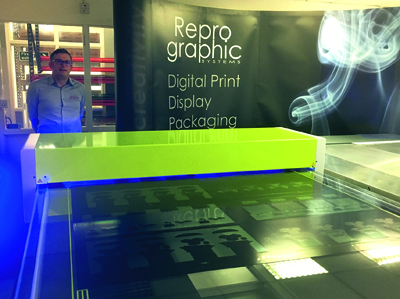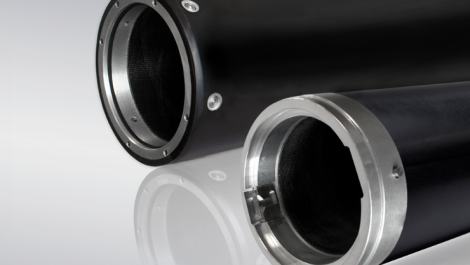Paul Vaughan, managing director, overseeing Esko’s XPS Crystal exposure unit at Reprographic Systems
Specialist repro houses have always been adept at proving themselves indispensible to the supply chain – no more so than now, reports Des King.
Whilst a core business activity might still be the on-demand provision of flexo plates to time-poor converters, specialist repro bureaux are steadily extending their horizons to offer a broader range of pre-press services across the overall supply chain; not solely because they can, but given an increasingly more accessible technology skill-set because they must.
With flexo separation a far more straightforward task than in the days when repro was widely considered to be the ‘black art’ of the printing process, the migration of platemaking in-house has definitely expanded observes Esko product manager David Harris. ‘With the greater consistency and reliability that’s being delivered it’s no longer necessary to do so much manual editing and tweaking as in the past – and which, of course, is what repro houses used to spend a lot of time doing, and which has presented them with both an opportunity and a threat.
‘On the plus side it can make the job of the repro house a lot easier; one of their core capabilities is delivering plates to many converters that they know are going to work with a high degree of reliability and in less time than previously. Conversely, however, it might also make them less essential to the process with converters enabled to do more of the pre-press work themselves; a knock-on effect being the consolidation taking place within the sector.
‘What we need to consider is what it is that these specialist companies are able to do within the context of a changing industry landscape. It may no longer be a viable commercial proposition to be just supplying plates or repro services to a few converters within a given geographical area; there needs to be more on offer, and additionally links with some major brands. That’s where companies like Schawk and Sun Graphics are positioned, of course; they do a lot more for the brands than just making plates.’
Comfort zone
Not every repro house will necessarily want to jeopardise its existing market status, however, by stepping outside of a well-established comfort zone. Nor should the deployment of shrewd investment in state of the art platemaking technology be disregarded as a means of maintaining a wholly tenable and successful business model – as is evidenced by the rapid gains in market share made by the fledgling pre-press house Victory Repro since it was founded barely three years ago.
‘Investment in Kodak Flexcel NX was an easy decision; its resolution is better than any other imaging technology and the surface pattern options can be adapted to requirements of presses, inks and substrates,’ said managing director Karl Pampus. ‘The benefits range from larger colour gamut and clearer print in highlights with open dark shadows to longer, cleaner print. Results are predictable and of consistently high quality.
‘We also understand how difficult it is to get press time to fingerprint due to press schedules and pressures; that’s why we decided to invest in the GMG OpenColor proofing colour management system which enables us to monitor press performance, over time, by placing minimal print furniture in trim areas. This enables us to spot print changes on the fly and eliminate potential issues before they become a problem. Previously the periodic shut down of a press and full fingerprint would have been required.’
Another option is to extend into a new format through realising the emerging potential open to a particular substrate due to retail trends. Derbyshire-based flexo plate manufacturer Qualiflex, for example, is looking to apply its existing pre-press skills in servicing the emerging corrugated market within the e-commerce sector, explained head of sales Ryan Eastwood. ‘Having slowly entered the corrugated marketplace over the past five years after seeing a dramatic increase of online shopping, we’re now aiming to build upon our expertise gained through wide web flexible packaging to become a leading supplier of origination and plates – and to improve on the market’s understanding of the current plate technology, especially the benefits of a flat top dot, something that is rarely explored in the industry.’

Mars Milky Way Hot Chocolate Pack was the first Project Blue award winner in a list that now numbers over 30 international ones since. The judges highly appropriate commendation was that the print quality was literally ‘out of this world’ (Reproflex3)
Brand matters
The direction of travel for an increasing number of repro bureaux, however, is in addition to providing its platemaking capabilities to the converter to draw upon other areas of pre-press expertise in order to get closer to the brand owner. Andy Hewitson, co-founder of Reproflex3, is well-advanced along the track towards proving that it is possible to do both. ‘What has enabled us to stand out in the pre-press industry is our in-depth knowledge and expertise in print quality management, carefully integrated into all the other services. This helps us to bring brand owners, creative agencies and print partners into a same platform.
‘Some of the projects we’ve managed lately have included plate life management which requires a deep subject understanding of many factors such as machine settings; ink solvent balance; plate cleaning and storage; anilox cell size and shape – not to mention design content, dot sizes etc. For the brand partners we are developing solutions on gravure to flexo conversion; ink GSM optimisation; print partner development; pre-press process optimisation etc. Our successes come when we work in the same open forum culture.’
Key to consistency
With blue-chip brand clients such as Danone baby-food and Mars confectionery packaging across EMEA, which requires them to work with a number of different converters and suppliers to minimise risks of disruption in the supply chain, Hybrid Software solutions user DSN Artwork is well aware of the necessity for demonstrating total brand integrity
on shelf irrespective of either substrate or location.
‘What a brand wants is consistency,’ said CEO Wim Demeestere. ‘They do not want to have it that consumers could see differences between different types of packaging; there should be a coherent look and feel, and that’s the essential added value that a specialist repro house can provide. Pre-press technology may have made it easier to create a file, but the simple fact is that a converter is never likely to have all of the packaging materials that the brand needs for a specific product.’
It is a key requirement for any brand irrespective of size, stressed Mr Demeestere. ‘The bigger the brand the more the complexity, of course, but a start-up will be faced with a lot of the same problems that a global brand needs to address. There isn’t one that I know of that only has a single packaging line or at least only needs one packaging format. There’ll always be a need for a multitude of different materials combined within the brand galaxy.’
Not surprisingly, Mr Demeestere is in no doubt as to who is best placed within the supply chain to deliver it. ‘We are for sure the colour and compliancy guardian. Whilst most of the design agencies would probably claim the title of brand guardian I would see that extension to brand guardianship applying more and more to the activity of repro too.’
Colour codes
It is a logical development with which one of the longest-established independent pre-press specialists Reprographic Systems would agree. With bases in Dublin, Lurgan and Chelmsford, whilst the core business is still platemaking – Reprographics was the first company to install the new Esko XPS Crystal 5080 exposure technology last year – being able to bring additional repro skills to bear in terms of colour management is a key objective, said managing director Paul Vaughn.
‘We’re keen to educate brands directly about the importance they need to attach to getting a consistent colour standard across all the different formats in which their product is sold, so we’re approaching brands that we don’t yet work with now and so won’t present a conflict as far as our core customer/printer base is concerned. That said, however, an increasing number of them are actively asking us to interact directly with their end-users on their behalf since they perceive the origination tasks and related functions to not be a part of their core business. The big repro houses such as Schawk have already gone this route. For a smaller business like us although we’re the biggest trade house in Ireland by a country mile, for us to grow we’ve got to seek out other markets within our skill-set.’
The company is itself currently going through a brand management exercise, says Mr Vaughn. ‘Research has indicated that whilst a lot of the brand owners in Ireland have sort of heard of us, they don’t really know what we do. Reprographic Systems doesn’t have any resonance as a brand so after almost 50 years of trading under it we’re now changing our name to Spera – dreamt up by my co-director Tom Fitzpatrick, who has a strong background in brand management – which means ‘trust’ in Latin. We’re also adopting the strap-line of ‘colour matters’. That really tells people what we’re about’.






